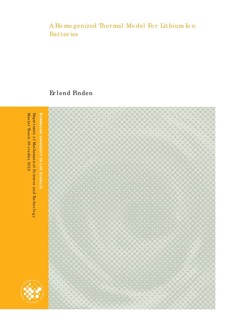| dc.contributor.author | Finden, Erlend | |
| dc.date.accessioned | 2012-09-03T12:51:29Z | |
| dc.date.available | 2013-09-05T23:04:18Z | |
| dc.date.issued | 2012-09-03 | |
| dc.identifier.uri | http://hdl.handle.net/11250/188803 | |
| dc.description.abstract | In this work homogenization theory is applied to existing thermal models for
lithium ion batteries. We study a battery with prismatic cell geometry. The
inner region of the battery has a thermal conductivity that is periodic in a
local variable. In this work we describe the inner region by a homogenized
partial differential equation. The obtained homogenized thermal conductivity
tensor is equivalent with the tensor obtained by applying a thermal
equivalent-resistance approach. Thermal equivalent-resistance approaches
are reported in the literature on thermal modeling of lithium ion batteries.
Furthermore, the homogenized thermal conductivity in different directions
varies by a factor 10. The outer region of the battery consist of a casing that
is wrapped around the inner region. The outer region is described by a nonhomogenized
partial differential equation. Both regions is described by the
two coupled partial differential equations in dimensionless form. The coupled
model is applied to a conventional lithium ion pouch-cell battery with 17.5
Ah capacity. Input data to the model are obtained from experiments. The
model is solved in 2 dimensions by means of the finite element method in
the FEniCS software. As input parameters, an ambient temperature and an
initial condition of 298 (K) are applied. Moreover is the external heat transfer
coe cient estimated to be 18 (W/m2 K). Simulations of a 1C discharge
from 100 to 10% state of charge is performed. The modeled battery consists
in 2 dimensions of a rectangle with long and short sides. It was found that
the temperature parallel with the long side varied significant compared with
the temperature parallel with the short side. A maximum temperature is
achieved in the center of the battery. This occurs at the time just before the
battery is at end of discharge. The maximum temperature is 2.4 (K) above
the ambient air temperature. A validation of the results are necessary. | no_NO |
| dc.language.iso | eng | no_NO |
| dc.publisher | Norwegian University of Life Sciences, Ås | |
| dc.subject | thermal modeling | no_NO |
| dc.subject | lithium ion batteries | no_NO |
| dc.subject | homogenization theory | no_NO |
| dc.title | A Homogenized Thermal Model For Lithium Ion Batteries | no_NO |
| dc.type | Master thesis | no_NO |
| dc.subject.nsi | VDP::Mathematics and natural science: 400 | no_NO |
| dc.subject.nsi | VDP::Mathematics and natural science: 400 | no_NO |
| dc.source.pagenumber | 154 | no_NO |
